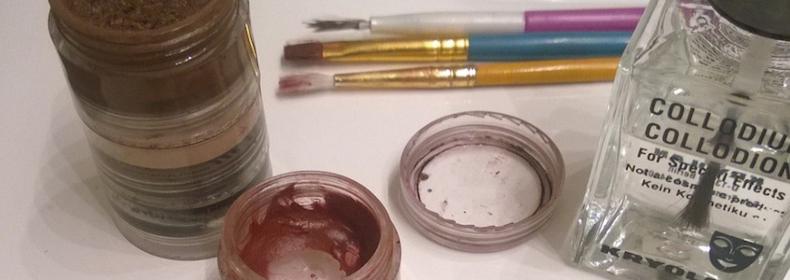


OFFICIAL MEDIA CHANNELS
New film trailers and videos
Check us out!
Check out Unreal Radio!
| The Unreal Film Festival is owned and managed by Cellardoor Cinema. Copyright 2015. |
| Unreal Film Fest Sponsors: |
Stay up to date on Fest News
|
|
Rigid Collodion is one of the easiest to use FX supplies there is. But first, know that it is very
much a flammable, chemical compound and needs to be treated with the proper respect. It also
has an odor similar to nail polish, only much stronger. It can also cause ALLERGIC REACTIONS
so be sure to ask your actors ahead of time about their allergies and if in doubt, do a small test on
an actor's arm to ensure there will be no allergic reactions.
much a flammable, chemical compound and needs to be treated with the proper respect. It also
has an odor similar to nail polish, only much stronger. It can also cause ALLERGIC REACTIONS
so be sure to ask your actors ahead of time about their allergies and if in doubt, do a small test on
an actor's arm to ensure there will be no allergic reactions.
Now, what is it that rigid collodion helps mimic so
well for us FX artists? Every cool scar or scabbing
you’ve seen in films is likely just grease make-up
under a layer or few layers of rigid collodion. It can
also be used to create realistic looking fresh cuts on
the skin as well, and in this article I'll give you a few
examples of both.
To demonstrate, you will need your own stacks /
grease paints, preferably use your dark red, bruised
purple and/or a dark brown color. Get yourself a
small, thin brush (or you can use a Q-tip) for each
color you want to use, and also, get another brush or
two specifically only for dipping into your rigid
collodion. Yeah, you can see that like finger nail
polish bottles, the bottle of collodion you purchase
may well come with its own brush, but you’ll likely
prefer as I do to use a thinner, finer haired art brush
with it.
well for us FX artists? Every cool scar or scabbing
you’ve seen in films is likely just grease make-up
under a layer or few layers of rigid collodion. It can
also be used to create realistic looking fresh cuts on
the skin as well, and in this article I'll give you a few
examples of both.
To demonstrate, you will need your own stacks /
grease paints, preferably use your dark red, bruised
purple and/or a dark brown color. Get yourself a
small, thin brush (or you can use a Q-tip) for each
color you want to use, and also, get another brush or
two specifically only for dipping into your rigid
collodion. Yeah, you can see that like finger nail
polish bottles, the bottle of collodion you purchase
may well come with its own brush, but you’ll likely
prefer as I do to use a thinner, finer haired art brush
with it.

Now to begin, start by choosing an area of skin that is mostly hairless, such as the back of
one's hand. The reason being that make-up can make the hair on skin stand out more and you
want to draw attention to the scar or wound, not the hair. You’ll see most films use rigid collodion
scarring or scabbing on actors’ necks, face and knuckles. Now while there are usually story driven
reasons for scars on an actor's face, neck, knuckles, it is also a very practical placement for scars.
one's hand. The reason being that make-up can make the hair on skin stand out more and you
want to draw attention to the scar or wound, not the hair. You’ll see most films use rigid collodion
scarring or scabbing on actors’ necks, face and knuckles. Now while there are usually story driven
reasons for scars on an actor's face, neck, knuckles, it is also a very practical placement for scars.

Per scarring, you’ll want to create thin lines of your red, purple or brown grease paints. In the
picture example above to the left, you see that I faded and feathered the brown and red lines, while
I left the dark purple line thicker and prominent. The reason for this will become quickly apparent
after taking a thin brush and tracing the lines with rigid collodion.
Rigid collodion dries in less than a minute, it has a pulling/drawing effect inward (into the line
itself that you brushed) and enhances a bit of whatever color under it. In the picture to the right,
you can see the result of the dried rigid collodion over grease paint. The faded brown line looks
like a tan or more aged scar. The faded red line looks like the kind of scarring that may fade into
white or was from a burn. The dark purple line looks more like a very recent and deep cut. That’s
just three colors of examples. A pink color will produce nice results, too. White will promote a
scarring that seems even longer healed over.
Not all scars are so simply just flat against the skin however. If you want a raised look, you’ll
likely have to use silicone or liquid latex. There are also inverse and deep, inset looking scars
too. Those can also be done, as I did in the examples below, by pinching skin together, then
marking with grease paints and then brushing over with rigid collodion…and you’ll have to hold the
pinched skin for a bit until it dries, too. Let go of the skin, and you’ll have yourself a much deeper
scar or even just a fresh cut.
picture example above to the left, you see that I faded and feathered the brown and red lines, while
I left the dark purple line thicker and prominent. The reason for this will become quickly apparent
after taking a thin brush and tracing the lines with rigid collodion.
Rigid collodion dries in less than a minute, it has a pulling/drawing effect inward (into the line
itself that you brushed) and enhances a bit of whatever color under it. In the picture to the right,
you can see the result of the dried rigid collodion over grease paint. The faded brown line looks
like a tan or more aged scar. The faded red line looks like the kind of scarring that may fade into
white or was from a burn. The dark purple line looks more like a very recent and deep cut. That’s
just three colors of examples. A pink color will produce nice results, too. White will promote a
scarring that seems even longer healed over.
Not all scars are so simply just flat against the skin however. If you want a raised look, you’ll
likely have to use silicone or liquid latex. There are also inverse and deep, inset looking scars
too. Those can also be done, as I did in the examples below, by pinching skin together, then
marking with grease paints and then brushing over with rigid collodion…and you’ll have to hold the
pinched skin for a bit until it dries, too. Let go of the skin, and you’ll have yourself a much deeper
scar or even just a fresh cut.

What other uses does rigid collodion have? Line a deeper scar look with a gel stage blood and
it’ll look perfect in that very John McClane of Die Hard is all beat up sort of way. This is exactly
how many films keep continuity with wound looks. Grease paints or just fake blood by themselves
will rub or sweat off in no time. Using rigid collodion as a means to really set cuts and such is a
better process. It’ll eventually crack up and peel off a bit, but you can just as quickly brush a thin
line right over your previous spot, and wa-laa, you’ve done touch up in under a minute.
For one last example of how great using rigid collodian is, take a look below at a grease painted
bite mark and then as it looks with a quick once over coat exactly on top of the painted marks.
it’ll look perfect in that very John McClane of Die Hard is all beat up sort of way. This is exactly
how many films keep continuity with wound looks. Grease paints or just fake blood by themselves
will rub or sweat off in no time. Using rigid collodion as a means to really set cuts and such is a
better process. It’ll eventually crack up and peel off a bit, but you can just as quickly brush a thin
line right over your previous spot, and wa-laa, you’ve done touch up in under a minute.
For one last example of how great using rigid collodian is, take a look below at a grease painted
bite mark and then as it looks with a quick once over coat exactly on top of the painted marks.




Rigid collodion can usually be found at stage make-up or prop supply companies, and while
there are many uses for rigid collodion in make-up and you can make some very realistic special fx
using it, remember that is is a chemical and can cause allergic reactions. So please, be careful,
and have fun.
Duane P. Craig is a writer and special FX artist in Memphis, TN and has been working in the
independent film industry since 2003.
there are many uses for rigid collodion in make-up and you can make some very realistic special fx
using it, remember that is is a chemical and can cause allergic reactions. So please, be careful,
and have fun.
Duane P. Craig is a writer and special FX artist in Memphis, TN and has been working in the
independent film industry since 2003.








